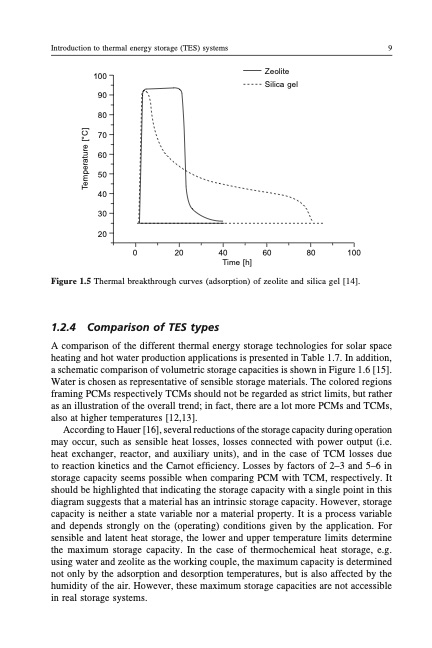
PDF Publication Title:
Text from PDF Page: 009
Introduction to thermal energy storage (TES) systems 9 100 90 80 70 60 50 40 30 20 Zeolite Silica gel 0 20 40 60 80 100 Time [h] Figure 1.5 Thermal breakthrough curves (adsorption) of zeolite and silica gel [14]. 1.2.4 Comparison of TES types A comparison of the different thermal energy storage technologies for solar space heating and hot water production applications is presented in Table 1.7. In addition, a schematic comparison of volumetric storage capacities is shown in Figure 1.6 [15]. Water is chosen as representative of sensible storage materials. The colored regions framing PCMs respectively TCMs should not be regarded as strict limits, but rather as an illustration of the overall trend; in fact, there are a lot more PCMs and TCMs, also at higher temperatures [12,13]. According to Hauer [16], several reductions of the storage capacity during operation may occur, such as sensible heat losses, losses connected with power output (i.e. heat exchanger, reactor, and auxiliary units), and in the case of TCM losses due to reaction kinetics and the Carnot efficiency. Losses by factors of 2–3 and 5–6 in storage capacity seems possible when comparing PCM with TCM, respectively. It should be highlighted that indicating the storage capacity with a single point in this diagram suggests that a material has an intrinsic storage capacity. However, storage capacity is neither a state variable nor a material property. It is a process variable and depends strongly on the (operating) conditions given by the application. For sensible and latent heat storage, the lower and upper temperature limits determine the maximum storage capacity. In the case of thermochemical heat storage, e.g. using water and zeolite as the working couple, the maximum capacity is determined not only by the adsorption and desorption temperatures, but is also affected by the humidity of the air. However, these maximum storage capacities are not accessible in real storage systems. Temperature [°C]PDF Image | Introduction to thermal energy storage TES systems

PDF Search Title:
Introduction to thermal energy storage TES systemsOriginal File Name Searched:
TES-introduction.pdfDIY PDF Search: Google It | Yahoo | Bing
Turbine and System Plans CAD CAM: Special for this month, any plans are $10,000 for complete Cad/Cam blueprints. License is for one build. Try before you buy a production license. More Info
Waste Heat Power Technology: Organic Rankine Cycle uses waste heat to make electricity, shaft horsepower and cooling. More Info
All Turbine and System Products: Infinity Turbine ORD systems, turbine generator sets, build plans and more to use your waste heat from 30C to 100C. More Info
CO2 Phase Change Demonstrator: CO2 goes supercritical at 30 C. This is a experimental platform which you can use to demonstrate phase change with low heat. Includes integration area for small CO2 turbine, static generator, and more. This can also be used for a GTL Gas to Liquids experimental platform. More Info
Introducing the Infinity Turbine Products Infinity Turbine develops and builds systems for making power from waste heat. It also is working on innovative strategies for storing, making, and deploying energy. More Info
Need Strategy? Use our Consulting and analyst services Infinity Turbine LLC is pleased to announce its consulting and analyst services. We have worked in the renewable energy industry as a researcher, developing sales and markets, along with may inventions and innovations. More Info
Made in USA with Global Energy Millennial Web Engine These pages were made with the Global Energy Web PDF Engine using Filemaker (Claris) software.
Sand Battery Sand and Paraffin for TES Thermo Energy Storage More Info
| CONTACT TEL: 608-238-6001 Email: greg@infinityturbine.com | RSS | AMP |